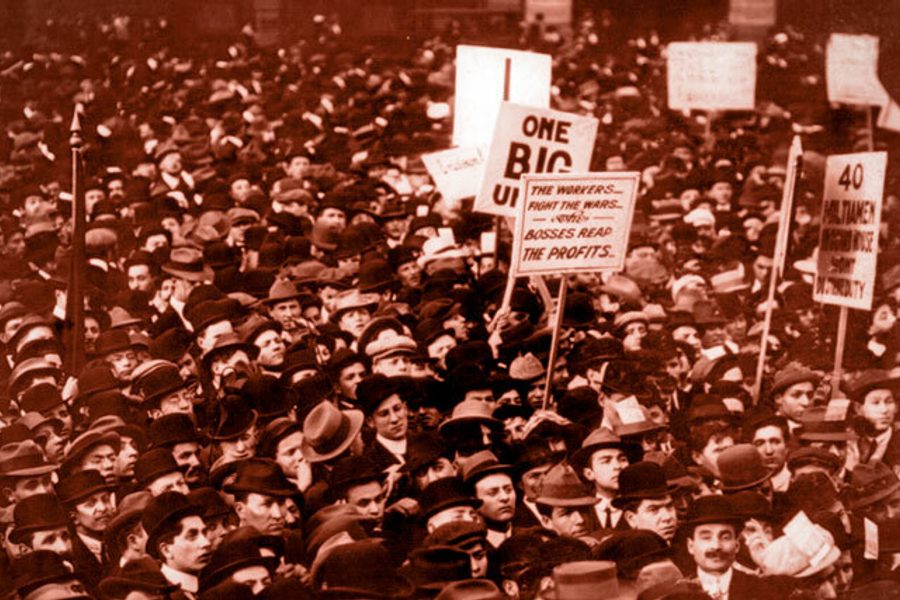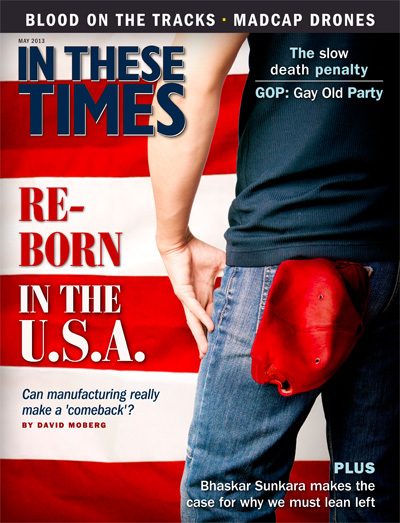
He wasn’t a household name, but for the last half of the 20th century Michael Harrington was the most prominent socialist in the United States. International leaders like Swedish Prime Minister Olof Palme said that if Harrington were European, he’d be a head of state — rather than simply a regular on late-night C-Span. William F. Buckley was more dismissive, noting, “Being called America’s foremost socialist is like being the tallest building in Topeka, Kansas.”
Since Harrington’s death in 1989, the decline of an already small American socialist movement has been even more pronounced. With even the most tepid forms of “liberalism” on the retreat in the United States, and something as economically rational as single-payer healthcare off the agenda entirely, more radical policies seem like the stuff of fantasy. Sure, socialism has its holdouts, but the truly committed domestic socialists now number in the thousands, not the millions. Much as Star Trek nerds make their pilgrimage to Trekkie conventions, this cadre flocks to Left Forum in New York City every year for heated arguments over this or that piece of sectarian esoterica.
The American democratic socialist movement today is marked by both a corrosive internal culture and absolute organizational disarray. When socialists do have impact it’s behind the veil of liberal-left groups, such as Progressive Democrats of America. For the most part, the “S-word” is seen as a liability and is kept hidden from sight. Aside from as a right-wing scare tactic, it goes without saying that socialism has no place within the mainstream American political landscape.
But despite this gloomy picture, there are signs that the cause may not be lost. A Pew poll last year found that more young Americans were favorably disposed to socialism than to capitalism. Even some of the more maligned aspects of Occupy activism pointed toward an underlying radicalism. The yearning for a more just economy seen in Zuccotti Park’s soup kitchen, or the thirst for deeper democracy embodied by Occupy Wall Street’s General Assemblies, represented profound aspirations, if only fleetingly realized. Members of a generation that came of age politically after the Cold War may not claim the label of “socialist,” but they don’t associate it with gulags and military parades, either.
Perhaps we should thank our conservative friends. The more Grover Norquist calls President Barack Obama’s centrist economic policies “socialist,” the less threatening that dreaded slur has started to sound.
Back to the future
Of course, socialism used to be more than a pejorative; it used to be a real political force espousing radical democracy and egalitarian redistribution. In 1912, the Socialist Party of America had 118,000 members and boasted 1,200 elected state officials, including 79 mayors. Workers in this country framed their demands in the language of homestead capitalism and republicanism more than their European counterparts, but they waged the same class struggle, fighting their employers for better wages and working conditions.
These radical currents ebbed and flowed, but in every major progressive advance, from the New Deal through the upsurges of the 1960s, American socialists played a key role. Since the 1970s, however, these victories have become rare. It’s no coincidence that decades of increasing economic inequity have coincided with the decline of the Left. Liberals in the United States never had much patience for socialists — but genteel establishment types would have had a hard time passing the New Deal without reds marching at their left, threatening more radical change. It was only after U.S. socialism retreated in disarray that the tides of neoliberalism moved in and significantly eroded the accomplishments of social democracy.
But those achievements can be won back. The essay I co-wrote with Peter Frase for In These Times last November, “The Welfare State of America,” argued that shifting social-spending burdens from states and localities to the federal government could make the welfare state more efficient, more sustainable and, crucially, more popular. We identified social actors whose interests would align with such a program — political constituencies such as labor that, once mobilized, could help usher in a new era of American social democracy.
Our proposal was not inspired by postwar nostalgia — a yearning for the kinder and gentler capitalism of yesteryear. Nor did we abandon the original socialist vision of a post-capitalist society. Instead, we proposed that certain reforms, once established, would both improve the conditions of working people in the immediate present while also setting the stage for more fundamental structural changes in the future. Unlike leftists who believe that things must get worse before they get better, we argue that the rank and file of the Next Left will need the psychological confidence that comes with winning intermediate victories, as well as the material security that comes with a robust safety net, before making any credible moves for more fundamental social change.
Refuseniks to the left, technocrats to the right
Such a process is inconceivable without a Left willing to engage with liberalism, but the trends in this respect are not promising. A peculiar brand of anarchism, prevalent during the Occupy movement, has attracted many young activists to its ranks. Their master plan for world change: Refuse to take power. Avoid politics. Occupy squats and “liberate space.” Celebrate liberalism’s collapse and hope something better will arise out of the rubble.
Given the political climate today, it’s understandable that so many radicals opt for hermetic purity and lifestyle posturing. Over the past three decades, the Democratic Party has turned in even more pro-corporate directions. It was Clinton, not Reagan, who was able to push through welfare reform; Obama, not Bush, who has put the future of Medicare at risk. Yet most traditional liberals have stood opposed to such policies. This distinction — between technocratic elites in the center-left coalition intent on managing the decline of the welfare state and liberal activists who want to see accomplishments of the New Deal and the Great Society defended and expanded — is key. After all, liberals clinging to faith in the welfare state would be a critical part of any broad Left anti-austerity coalition.
The American welfare state was the product of a specific historical moment; its ideological architecture was buttressed by the New Deal and by the experience of a highly coordinated wartime economy of the 1940s. More importantly, it emerged during the plenty of a postwar economic boom, with the help of a mass labor movement that in 2013 shows no sign of resurrecting itself to its former glory.
The different ways in which liberals assess this history reveal interesting fractures in the liberal camp. In one corner, labor-oriented liberals rightly pine for that bygone era’s economic security and still dream that someday the promise of mid-century liberalism will be realized in the form of a more robust industrial democracy. In the other corner are those aligned with the professional liberal policy class, like the Washington Post’s Ezra Klein, who in a January 18 blog post titled “After ‘the end of big government liberalism’ ” wrote, “The progressive project of building a decent welfare state is giving way to the more technocratic work of financing and managing it.” Hence the existing safety net must be pruned and innovated upon until it can mesh with the demands of a globalized economy.
These liberal technocrats aren’t idiots. Their understanding of the structural basis of the 1970s economic crisis that undid much of American social democracy and inaugurated neoliberalism is more sophisticated than that of their labor-Left peers. But the disconnect between the aspirations of liberal policy types and the voting blocs they rely on politically is striking. This is a divide socialists can exploit. The bloodless wonkery of Beltway liberals — the corps of writers who are heralded as the “ideas people” of American liberalism — presents the Left with an opportunity to rebuild a rapport with the broader progressive movement, an audience starved for alternatives to austerity.
Out of Kansas
A new New Deal alliance would bode well for the liberal-Left, but playing a role in rejuvenating American liberalism will only be a means to an end. That’s where Michael Harrington and his co-conspirators, many of whom were leaders of the labor movement, erred. Their folly wasn’t a hostility to engagement with liberals, like that of today’s anarchist youth, but that their political strategy by design played second fiddle to, and eventually became indistinguishable from, that of their liberal counterparts. Given the chance during the high-water mark of American liberalism, they were unable to build their own institutions and struggle for dominance within the broader progressive coalition.
Through outreach and agitprop, today’s democratic socialists will need to push popular analysis and display organizational talents more dynamic than liberalism can offer. This will mean working openly under the socialist banner, identifying capitalism as a social system that benefits a tiny minority at the expense of everyone else, and organizing within our communities, schools and workplaces to challenge the structures and relationships that dominate our lives. It’ll mean creating parties and organizations distinct from those on the American political scene today, but not remote from ordinary people’s lived realities.
The only way back to political relevance for socialists lies through realistic engagement with politics as it exists today. And that involves messiness and compromise — reaching out to liberals as friends and allies — while not losing sight of the need to decisively transform a political framework built on a self-destructive and morally intolerable mode of production.
Bhaskar Sunkara is the president of The Nation magazine and the founding editor of Jacobin. Follow him on Twitter: @sunraysunray.








